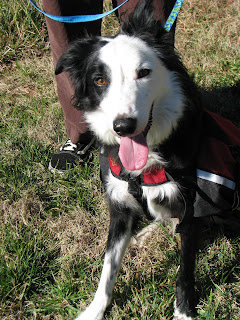It is a rewarding experience to be able to bring your dog camping with you. After all, nothing beats having your favorite sidekick sitting with you in the warm glow of the camp fire or gracefully blazing the trail with you. But there are some considerations and preparations that help make this experience a natural, harmonious endeavour.
 First, consider who your dog is. Think about how he interacts with people, such as meeting strangers on the trail and walking by groups of people. Give consideration to health problems or limitations that your dog may have. For example, older dogs may have hip problems or smaller dogs may have difficulties in keeping your pace. If you are going to be strapping a pack onto your dog, do not overload and provide ample water to drink. For example, my dog carries a bottle of water, small plastic bag of food, a few treats that are high in fat and protein, and a portable water/food bowl. For toys, he finds sticks to play with along the way.
First, consider who your dog is. Think about how he interacts with people, such as meeting strangers on the trail and walking by groups of people. Give consideration to health problems or limitations that your dog may have. For example, older dogs may have hip problems or smaller dogs may have difficulties in keeping your pace. If you are going to be strapping a pack onto your dog, do not overload and provide ample water to drink. For example, my dog carries a bottle of water, small plastic bag of food, a few treats that are high in fat and protein, and a portable water/food bowl. For toys, he finds sticks to play with along the way. Dogs are constantly being bombarded by smells and sounds that could attract them, so do not let them out of your sight. There's nothing worse than having your best friend return to camp smelling of dead opossum. Make sure that your dog does not ingest anything it is not supposed to. Mushrooms are the first thing that comes to mind, but food scraps are probably more common as a means to making your dog sick. When your dog has to make a waste deposit be watchful and clean up the mess. Nothing worse than stepping in a smelly mess on the trail. Apart of keeping watch over your dog is making sure they are leashed where required.
 Leashing your dog ensures his safety and you a level of control over his actions. Some people may not want to be greeted with two muddy paws. Leashing also ensures the safety of others in the area. Horses are usually an uncommon site that sends most dogs into frenzies. If your dog spooks the horse and it reciprocates by throwing its rider, you're in a bad spot. Leashing keeps you and your dog in a good range for communication. It is nice to be able to give commands when needed, but also casual conversation will more likely occur.
Leashing your dog ensures his safety and you a level of control over his actions. Some people may not want to be greeted with two muddy paws. Leashing also ensures the safety of others in the area. Horses are usually an uncommon site that sends most dogs into frenzies. If your dog spooks the horse and it reciprocates by throwing its rider, you're in a bad spot. Leashing keeps you and your dog in a good range for communication. It is nice to be able to give commands when needed, but also casual conversation will more likely occur. Double check your resources and itinerary to make sure accommodations are made for your dog. Decide before heading out, whether your dog will sleep in the tent, what to do if it rains, and how to accommodate him being with you at all times.. Nobody wants to hear a dog left at the campsite barking, crying all day; it creates stress for everyone and is not fair for the dog.
Having your dog at camp is real treat for both you, him, and others you may pass. Follow the above guidelines and you can't go wrong with camping out with canines.






























